There are several video producers who work directly with brands and post links within their uploaded programs to spread the word – but YouTube could be changing the way you see these videos.
The company has amended its ad policies to block “graphical title cards” from sponsors that aim to promote certain brands and products on YouTube channels, according to Digiday. This comes from a revised FAQ document in YouTube’s support section, which indicates that video overlays of sponsor logos and product branding aren’t allowed anymore – unless there’s a deal where the sponsor pays Google directly in terms of advertising on its channel.
When speaking with a YouTube rep, Digiday pointed out that they called this a revision of its existing policy, which actually took place late last year. It was put in place to prevent advertiser conflicts and ensure viewers don’t become overwhelmed with ad presence with videos.
Not everyone is crazy about the move, as Paul Kontonis, executive director of the Global Online Video Association, deemed the change as explicit, preventing YouTube stars and multichannel networks from including necessary sponsor logos and images into their videos. He feels that Google is trying to take too much of a cut from sales.
The company also introduced a new “product card” program, which provides a six-second pre-roll spot on videos. It will remain outside of the main content of a program, but it’s built within the stream, allowing brands to sponsor certain comment. This is sure to become part of standard media packages for ad sales, according to Kontonis, but YouTube hasn’t officially commented on it yet.
As a result of these programs, YouTube could possibly take a bigger cut from certain partners, as its revenue-sharing terms currently show it gets 45 percent, while the rest go to the partner channel.
“We allow text-only title cards where there is paid product placement for the purpose of paid product disclosure only,” reads the new plan on the YouTube page. “Graphical title cards, including the use of sponsor logos and product branding, are prohibited unless there is a full Google media buyout on the partner content by the sponsor.
Kontonis explained, “YouTube needs to do it, because in their minds they are losing money to product integration and sponsorships within video. But this industry is still in the first inning, so to be putting all these constructs into place that take more revenue away from the networks that are helping build the quality of the content, audience and monetization opportunities is shortsighted.”
Creators aren’t likely to be pleased with the new program. “It’s especially poor timing on YouTube’s part with Vessel taking off at the moment, because that (platform) is specifically targeted towards content creators earning more revenue,” said Jan Dawson, chief analyst for Jackdaw Research. “If YouTube is cracking down on ways of monetizing on YouTube itself, that will just drive people into the arms of Vessel and some of those newer video platforms.”
We’ll see how it does over the next few months, but it seems that YouTube could possibly lighten up on the restrictions a little. Or maybe even a lot.

